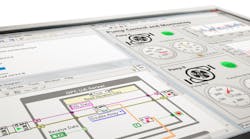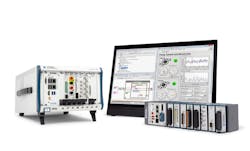Download a PDF of this article.
National Instruments’ (NI) annual NI Week is where the company highlights its latest and greatest software, including new versions of LabVIEW. This year is no different and the centerpiece is LabVIEW, but this year there is a dichotomy. LabVIEW 2017 is a continuation built on LabVIEW 2016, but there is also the new LabVIEW NXG (see “What’s the Difference Between LabVIEW 2017 and LabVIEW NXG?”). Both are actually in the same box but the features and user interfaces differ. (Also, check out “Introducing LabVIEW NXG” for more details of the new approach to LabVIEW.)
Here we take a look at LabVIEW 2017. It is designed to be backward-compatible with LabVIEW. It is possible to migrate most applications from LabVIEW 2017 to LabVIEW NXG, but there is no way to move projects designed in LabVIEW NXG to LabVIEW 2017.
At this point, LabVIEW 2017 is the feature-rich version that supports all the features and platforms that developers have come to know and love. This includes targeting FPGAs and embedded systems as well as test-and-measurement hardware like NI’s CompactRIO. The user interface is maintained so users of LabVIEW 2016 and earlier version will be quite comfortable with LabVIEW 2017. LabVIEW 2017 and LabVIEW NXG use a common G language compiler.
LabVIEW 2017 is backward-compatible and supports all LabVIEW targets like CompactRIO.
The Labview 2017 user interface (UI) will look familiar. There is improved control customization as well as enhanced editing and viewing improvements. The LabVIEW Cloud Toolkit for AWS connects LabVIEW applications to Amazon Web Services (AWS).
The Object Management Group’s (OMG) Data Distribution Service (DDS) has proven a useful publish/subscribe communications mechanism for many applications. LabVIEW 2017 supports integration with Real Time Innovations Connext DDS using the RTI DDS Toolkit for LabVIEW. RTI’s latest DDS incarnation supports OMG’s new security standard for DDS.
LabVIEW 2017 includes support for a new LabVIEW OPC UA Tookit and the LabVIEW FPGA IEC 61131-3 Interface Utility. This provides LabVIEW applications with access to a large ecosystem of industrial automation devices.
One feature I really like is the ability to create a channel wire. This is part of the improvements in LabVIEW 2017 to simplify abstract programming tasks. Channel-wire support for FPGAs provides an asynchronous communication support for user-defined malleable virtual instruments (VIs) that can then perform actions without creating including additional logic connections.
One item on the horizon is the “SystemLink” Early Access Release that is designed to deliver remote system monitoring, software deployments, and data communications for LabVIEW applications. This will allow management and deployment of large, distributed systems.
By the way, LabVIEW 2017 and LabVIEW NXG come in the same box. Developers can use both as desired. As noted, there are functional differences between the two so developers may wind up working with one or the other depending upon the projects. LabVIEW 2017 lacks some of the ease-of-use features found in LabVIEW NXG, but LabVIEW 2017 provides access to all targets and add-ons currently available where LabVIEW NXG handles a subset.



